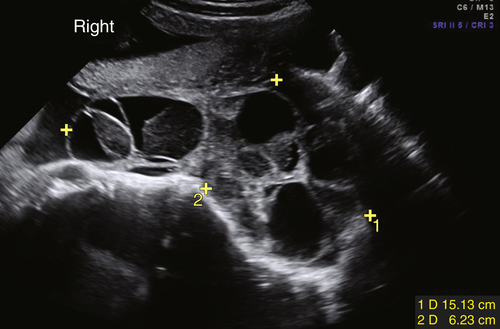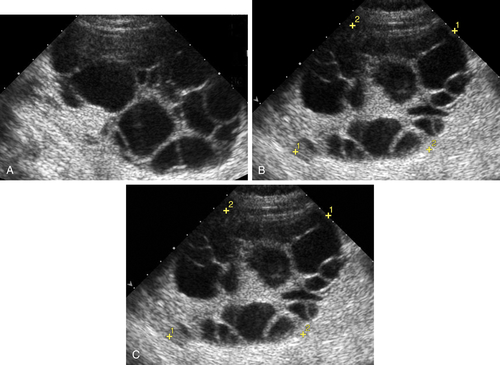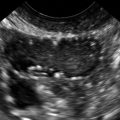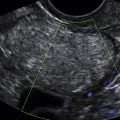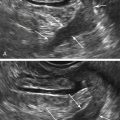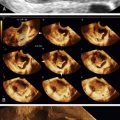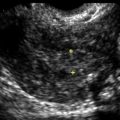Theca Lutein Cyst
Synonyms/Description
Hyperreactio luteinalis
Etiology
Theca lutein cysts are benign, functional cysts of pregnancy. They are usually multiple, bilateral, and large. The exact etiology is unknown but is associated with high circulating levels of (or an increased sensitivity to) human chorionic gonadotropin (hCG), the “hormone of pregnancy.” They are typically seen in patients with trophoblastic disease, with multiple pregnancy, or who have undergone infertility treatment (ovarian stimulation followed by pregnancy). Up to 50% of patients with molar pregnancies and 10% of patients with choriocarcinoma develop theca lutein cysts. Occasionally, theca lutein cysts can occur in pregnancies associated with large placentas, such as those affected with diabetes or Rh sensitization. Rarely, they can also occur in normal, singleton pregnancies.
Ultrasound Findings
Theca lutein cysts are large, usually bilateral, adnexal masses that consist of many thin-walled smaller cystic components, giving them the appearance of a “spoke wheel.” The cystic components are typically anechoic, although focal hemorrhage can occur, demonstrated as internal echoes. Bilateral, multiple, predominantly clear, large cysts in a pregnant patient should be highly suggestive of theca lutein cysts. Color Doppler should be considered to exclude torsion since these patients are at increased risk.
Differential Diagnosis
Although there is a vast differential diagnosis, including many benign ovarian tumors, the presence of bilateral symmetric, anechoic cysts with the characteristic spoke-wheel appearance in a pregnant patient is virtually pathognomonic for theca lutein cysts.
Clinical Aspects and Recommendations
Theca lutein cysts are functional cysts, which are usually asymptomatic and spontaneously resolve during pregnancy or in the postpartum period. Intervention is only indicated if they become symptomatic and conservative management is not an option. These masses increase the risk of ovarian torsion; if suspected, they require immediate surgical management. Theca lutein cysts can occur in patients with gestational trophoblastic disease, in which the treatment should be based on the trophoblastic tumor rather than the accompanying cysts.
Figures
Suggested Reading
Amoah C., Yassin A., Cockayne E., Bird A. Hyperreactio luteinalis in pregnancy. Fertil Steril. 2011;95:24–29.
Holsbeke C., Amant F., Veldman J., de Boodt A., Merman P., Timmerman D. Hyperreactio luteinalis in a spontaneously conceived singleton pregnancy. Ultrasound Obstet Gynecol. 2009;33:371–373.
Suzuki S. Comparison between spontaneous ovarian hyperstimulation syndrome and hyperreactio luteinalis. Arch Gynecol Obstet. 2004;269:227–229.

